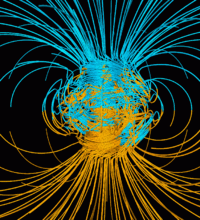
Photo from wikipedia
MR-guided radiotherapy (MRgRT) is one of the most significant advances in radiotherapy in recent years. The hybrid systems were designed to visualize patient anatomical and physiological changes during the course… Click to show full abstract
MR-guided radiotherapy (MRgRT) is one of the most significant advances in radiotherapy in recent years. The hybrid systems were designed to visualize patient anatomical and physiological changes during the course of radiotherapy, enabling more precise treatment. However, before MR-linacs reach their full potential in delivering safe and accurate treatments to patients, the radiotherapy team must understand how a magnetic field alters the dosimetric properties of the radiation beam and its potential impact on treatment quality and clinical outcomes. This review aims to provide an in-depth description of the magnetic field induced dose effects for the two widely available systems, the 0.35 T and the 1.5 T MR-linacs. In MR-linac treatments, the primary photon beam passes through MR components that never exist in conventional linacs, which alter both in-field and out-of-field doses. More importantly, the interplay between the always-on magnetic field and the secondary electrons is not negligible. This interplay affects dose deposition in the patient, resulting in reduced in-field skin dose due to purged-out contaminant electrons, shortened build-up distance and a shifted crossline profile owing to asymmetric dose kernel. Especially two effects, namely electron return effect (ERE) and electron stream effect (ESE), are not seen in conventional radiotherapy. This review also summarizes the clinical observations on the site-specific treatments influenced mostly by the magnetic field. In MR-linac treatment, the head and neck region is one of the most challenging sites as ERE occurs at low and high density tissue interfaces and around air cavities, generating hot and cold spots. In breast cancer treatment, consideration should be given to the increased in-field skin dose induced by ERE and the increased out-of-field dose caused by ESE for regions such as the ears, chin, and neck. In lung cancer treatments, tissue inhomogeneity combined with ERE will exacerbate target dose heterogeneity and increase or decrease interface dose. Lastly, treatment in the abdomen and pelvic region will be affected by the presence of gas pockets near the target. The review provides practical recommendations to mitigate these effects. This article is protected by copyright. All rights reserved.
Journal Title: Medical physics
Year Published: 2023
Link to full text (if available)
Share on Social Media: Sign Up to like & get
recommendations!